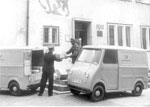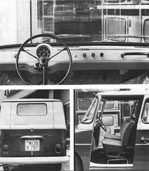 |
| Bundespost Goggomobil |
After this failed attempt the Bundespost turns over to the Volkswagen Works. Volkswagen is all ears for the postal delivery problems and contacts the Westfalia Works. This versatile company from Rheda-Wiedenbrück, Germany is already doing special upgrades and conversions on postal vehicles. During February 1962 the Bundespost is expressing its wishes in a first, preparing meeting:
- 2 m³ (71 cubic feet) storage compartment
- Payload between 350 and 400 kilograms (772 to 882 pounds)
- Length 3.750 mm (12.3 feet)
- Width 1.440 mm (4.7 feet)
- Height 1.700 mm (5.6 feet)
The parts necessary for assembly - if not being produced by Westfalia itself - should be delivered by the Volkswagen Works and Karmann in Osnabrück. Those parts were components of the following VW models:
 |
| Postal VW Fridolin |
Almost two months later Westfalia presented the first two construction drawings to the Bundespostministerium (Postal Ministry). Additionally a plastic model in scale 1:8 was finished at the same time. In January 1963 the parties involved surveyed the first full size Fridolin dummy in Wiedenbrück; its inner height had been reduced by 9 cm (3.54 inches) in the short term. After extensive agreements concerning the exterior and interior configuration and renewed survey of the dummy, end of February Westfalia was given an order for three sample vehicles in the first instance; two more should follow later.
In August 1963 the type approval for the prototypes 1 and 2 took place at TÜV (Technical Inspection Association) in Hannover. Prototype 1 remained at the Volkswagen Works for technical testing, prototype 2 went to the Posttechnisches Zentralamt (Postal Technical Commission) in Darmstadt as a testing and demonstration car.
During the International Motor Show of September 1963 prototype 2 was displayed in the yard of the Oberpostdirektion Frankfurt (Head of Postal Commission) and shown to some postal departments of other countries at this occasion. The „Fridolin” received much interest.
In Cctober the third prototype was finished; it essentially resembled the later mass-produced model. After finishing the preparations needed for the start of mass-production (tool construction, type registration and license), the mass-production of VW 147 started in 1964 at Westfalia.
 |
| VW Fridolin from all sides |
It provided the usual engine with 1192 ccm (72.74 cubic inches) and a power rating of 34 HP at 3600 rpm. Engine gate and other parts came from the Transporter, headlights and various components from the VW 1500 (Type 3). The overall ready to start weight of the Fridolin was 935 kg (2061 pounds), which was approx. 200 kg (441 pounds) heavier than an Export Beetle.
With these specifications it clearly had no hot temper, but this was not that important at all. Accessibility, generous storage space and low running costs played the leading role.
In practice the „Sonderfahrzeug Post” fully met all expectations. During more than a decade the VW 147 was used as standard vehicle of the mailmen, mailbox emptiers and counter photographers of the signal-service and in other areas of the Bundespost - and extraordinarily popular due to its versatility.
The two slide doors allowed to comfortably get in and out, without hampering the running traffic − especially important in the inner city area. Over that a few Fridolins were delivered to other customers, for example to Lesezirkel-Service (Reader Community Service) in Lippstadt or as field service car for the german airline „Lufthansa”.
In total 6139 cars were built until 1972 for the german car market; 85% of them for use in the Bundespost. The rest was delivered to german companies and local authorities, even the norwegian general importer brought one Fridolin to Oslo. Also the Schweizer Bundespost PTT (Swiss Postal Service) ordered 1201 cars, although in a modified version due to changed requirements: They had a 1,3 litre 44 PS engine, front disk brakes, auxiliary heater, ventilation hatch in the roof, outside mirrors not attached to the doors but to the front fenders, a custom made interior paneling, a larger scale window in the tailgate and during the last years of manufacture additional windows in the rear corners, to improve the view from within the car. In 1974 the production of the Fridolin ended, but a small reserve stock of new cars was put into commission by the PTT until 1977.
Only a small number of the „VW Kleinlieferwagen” (small delivery van) did survive until the present date − poor rust precaution is the main reason. Neither Westfalia, nor first owner Bundespost, nor most of the later owners did care at all − unfortunately !